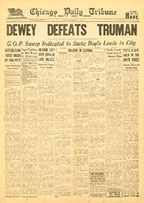
***EXTRA! Heads Up Headlines EXTRA!***
"I
hear the headlines on the radio, see them on TV and read them in the paper.
When I hear from the men out there, I sometimes don't believe they are talking
about the same situation."
-Lyndon B. Johnson

This famous headline written on the eve of the 1948 presidential election is a striking example of how headlines can mislead. This particular headline evolved from an eagerness by the press to be the first to print the election results without confirmation of the actual results. Most examples of misleading headlines are not this glaring, and tend to be much more subtle. Many people will choose to read an article or not solely based on it's headline, and many people take their news directly from the headlines without bothering to read the article the accompanies it.
The purpose of this activity is to get you thinking about how the information provided in a headline is used to evoke a response in the reader. To illustrate this point click on the headlines below and attempt to predict the content and possibly even the slant of the article based on what the headline tells you.
TEST YOURSELF!
Click on these actual headlines and try to predict the content
of the articles they are introducing:
"Relief Comes in Bag of Skittles"
Questions to Consider:
- What do you expect this article to be about? (What is the issue being addressed? Identify the setting-Who is involved? What is the story?)
- What words in the headline helped you most with your prediction?
- What words in the headline presented you with the most difficulty? (Which words were ambiguous or counter-intuitive?)
- Based on the headline do you expect this article to be slanted in one way or another? (Politically? Sensationalist vs. Objective?)
After you have answered these questions thoughtfully take some time to think about how your prediction may have differed from others and note the specific aspects of the headline that led you to your prediction. Click on the FULL ARTICLE to compare your prediction with the actual content that followed this headline.
"Smiley face artist may face charges"
Questions to Consider:
- What do you expect this article to be about? (What is the issue being addressed? Identify the setting-Who is involved? What is the story?)
- What words in the headline helped you most with your prediction?
- What words in the headline presented you with the most difficulty? (Which words were ambiguous or counter-intuitive?)
- Based on the headline do you expect this article to be slanted in one way or another? (Politically? Sensationalist vs. Objective?)
After you have answered these questions thoughtfully take some time to think about how your prediction may have differed from others and note the specific aspects of the headline that led you to your prediction. Click on the FULL ARTICLE to compare your prediction with the actual content that followed this headline.
"Man with syringe arrested in hospital"
Questions to Consider:
- What do you expect this article to be about? (What is the issue being addressed? Identify the setting-Who is involved? What is the story?)
- What words in the headline helped you most with your prediction?
- What words in the headline presented you with the most difficulty? (Which words were ambiguous or counter-intuitive?)
- Based on the headline do you expect this article to be slanted in one way or another? (Politically? Sensationalist vs. Objective?)
After you have answered these questions thoughtfully take some time to think about how your prediction may have differed from others and note the specific aspects of the headline that led you to your prediction. Click on the FULL ARTICLE to compare your prediction with the actual content that followed this headline.
"Student shot at Detroit high school by gun in pocket"
Questions to Consider:
- What do you expect this article to be about? (What is the issue being addressed? Identify the setting-Who is involved? What is the story?)
- What words in the headline helped you most with your prediction?
- What words in the headline presented you with the most difficulty? (Which words were ambiguous or counter-intuitive?)
- Based on the headline do you expect this article to be slanted in one way or another? (Politically? Sensationalist vs. Objective?)
After you have answered these questions thoughtfully take some time to think about how your prediction may have differed from others and note the specific aspects of the headline that led you to your prediction. Click on the FULL ARTICLE to compare your prediction with the actual content that followed this headline.
"Sitting in a parked car gets 4 men into trouble"
Questions to Consider:
- What do you expect this article to be about? (What is the issue being addressed? Identify the setting-Who is involved? What is the story?)
- What words in the headline helped you most with your prediction?
- What words in the headline presented you with the most difficulty? (Which words were ambiguous or counter-intuitive?)
- Based on the headline do you expect this article to be slanted in one way or another? (Politically? Sensationalist vs. Objective?)
After you have answered these questions thoughtfully take some time to think about how your prediction may have differed from others and note the specific aspects of the headline that led you to your prediction. Click on the FULL ARTICLE to compare your prediction with the actual content that followed this headline.